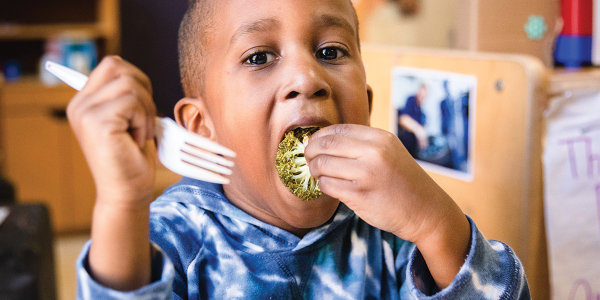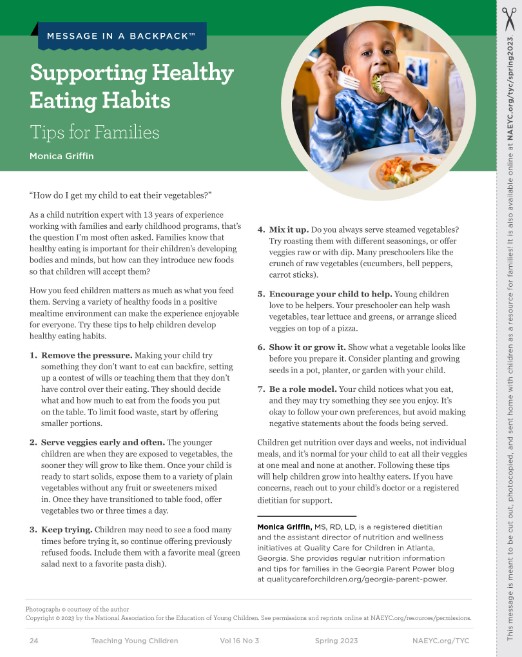Message in a Backpack™ Supporting Healthy Eating Habits: Tips for Families

You are here
“How do I get my child to eat their vegetables?”
As a child nutrition expert with 13 years of experience working with families and early childhood programs, that’s the question I’m most often asked. Families know that healthy eating is important for their children’s developing bodies and minds, but how can they introduce new foods so that children will accept them?
How you feed children matters as much as what you feed them. Serving a variety of healthy foods in a positive mealtime environment can make the experience enjoyable for everyone. Try these tips to help children develop healthy eating habits.
- Remove the pressure. Making your child try something they don’t want to eat can backfire, setting up a contest of wills or teaching them that they don’t have control over their eating. They should decide what and how much to eat from the foods you put on the table. To limit food waste, start by offering smaller portions.
- Serve veggies early and often. The younger children are when they are exposed to vegetables, the sooner they will grow to like them. Once your child is ready to start solids, expose them to a variety of plain vegetables without any fruit or sweeteners mixed in. Once they have transitioned to table food, offer vegetables two or three times a day.
- Keep trying. Children may need to see a food many times before trying it, so continue offering previously refused foods. Include them with a favorite meal (green salad next to a favorite pasta dish).
- Mix it up. Do you always serve steamed vegetables? Try roasting them with different seasonings, or offer veggies raw or with dip. Many preschoolers like the crunch of raw vegetables (cucumbers, bell peppers, carrot sticks).
- Encourage your child to help. Young children love to be helpers. Your preschooler can help wash vegetables, tear lettuce and greens, or arrange sliced veggies on top of a pizza.
- Show it or grow it. Show what a vegetable looks like before you prepare it. Consider planting and growing seeds in a pot, planter, or garden with your child.
- Be a role model. Your child notices what you eat, and they may try something they see you enjoy. It’s okay to follow your own preferences, but avoid making negative statements about the foods being served.
Children get nutrition over days and weeks, not individual meals, and it’s normal for your child to eat all their veggies at one meal and none at another. Following these tips will help children grow into healthy eaters. If you have concerns, reach out to your child’s doctor or a registered dietitian for support.
Download the PDF for this Message in a Backpack™ here!
Photograph: courtesy of the author
Copyright © 2023 by the National Association for the Education of Young Children. See permissions and reprints online at NAEYC.org/resources/permissions.
Monica Griffin, MS, RD, LD, is a registered dietitian and the assistant director of nutrition and wellness initiatives at Quality Care for Children in Atlanta, Georgia. She provides regular nutrition information and tips for families in the Georgia Parent Power blog at qualitycareforchildren.org/georgia-parent-power.
